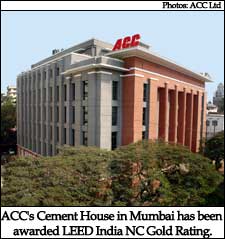Retrofitting Old Buildings
 By 2025, buildings will be the single largest energy consumers and emitters of greenhouse gasses on our planet. It is estimated that in a typical residential building, around 28 per cent of the total electricity is consumed for lighting, 45 per cent for air conditioning, 13 per cent for refrigeration, 4 per cent for televisions and 10 per cent for other appliances in the urban sector. Nand Kumar, Vice President, Corporate Communications, ACC Ltd, dwells on the need for appropriate efforts to bring down carbon emissions from the building sector.
By 2025, buildings will be the single largest energy consumers and emitters of greenhouse gasses on our planet. It is estimated that in a typical residential building, around 28 per cent of the total electricity is consumed for lighting, 45 per cent for air conditioning, 13 per cent for refrigeration, 4 per cent for televisions and 10 per cent for other appliances in the urban sector. Nand Kumar, Vice President, Corporate Communications, ACC Ltd, dwells on the need for appropriate efforts to bring down carbon emissions from the building sector.
India’s current floor area of buildings has nearly doubled in the last decade. By 2050, it is estimated that India will add about 35 billion m2 of new building floor area given the accelerating growth rate of construction and shortage of houses. Every new building is implanting a huge carbon footprint buildings alone are responsible for at least 40 per cent of energy use in most countries. Today, India has merely 2,111 registered green buildings covering 1.54 billion sq. ft, according to the Indian Green Building Council.
These hard hitting facts have led business leaders, government officials and non-governmental organisations to address one intrinsic question: why energy efficiency should be an integral part of architecture, engineering and construction process?
Residential building makes up 75 per cent of India’s construction market yet until now has not been a priority for energy efficiency policy. The household sector is the single largest consumer of energy in India, accounting for 40-50 per cent of the total energy consumption in the country. In rural areas, the residential (domestic sector) accounts for nearly 80 per cent of the consumption of energy. The resulting carbon emissions are substantially more than those in the transportation sector.
While new buildings that will use more energy than necessary are being built every day, millions of today’s inefficient buildings will remain standing by 2050. Urbanisation and economic growth in India point to the rapid growth of new building stock. Thus, an economical and sensible industry practice in India would be to take into account sustainable building considerations at the time of design and construction. However, the green construction and energy efficiency is limited within the boundaries of new construction. A significant chunk of existing buildings in India still continue to largely contribute to greenhouse gas emissions, a major cause of concern for the country.
Can old existing buildings be energy efficient at all? The answer is yes.
Green retrofitting of old buildings is one such solution to answer energy efficiency queries. It carries higher costs at a later stage invariably, both financially and environmentally than integrating sustainability considerations already at the early stages of design and construction. But it rationalises the cost of retrofitting in the long run with lesser energy and water consumption bundled with the satisfaction alone of not being environment polluters.
 In the year 2008, Mumbai had 30 registered green projects and was leading the green building movement in the country. Today, the country has seen a spurt in the number of construction projects compete for the green tag. Currently, there are over 2,000 green buildings in India out of which 267 green building projects are certified and fully functional. These include offices, factories, hospitals, hotels, IT parks, airports, banks, residential spaces, SEZs and townships among others.
In the year 2008, Mumbai had 30 registered green projects and was leading the green building movement in the country. Today, the country has seen a spurt in the number of construction projects compete for the green tag. Currently, there are over 2,000 green buildings in India out of which 267 green building projects are certified and fully functional. These include offices, factories, hospitals, hotels, IT parks, airports, banks, residential spaces, SEZs and townships among others.
Mumbai itself has about 250 buildings registered with Indian Green Building Council, which are at various stages of construction. Mumbai ranks second in the country with 36 rated operational green buildings.
However, these green buildings constitute a mere 2 per cent of the number of total buildings in the country. The rest 98 per cent are old existing buildings which have to be regularly maintained and which consume maximum amount of energy.
Energy efficiency of new buildings determines the energy consumption for far longer than in other end-use sectors. Unfortunately, projects and legislation are based on short payback times on a few years. Energy issue buildings should be evaluated over lifetime of the building or at least over 30 years. Since buildings are typically renovated several times, (residential every 30-40 years), renovation offers a special opportunity for improvements of energy efficiency. But it has to be done right in the first place! By construction!
Sustainability may be a buzzword today, but defining sustainability in habitats is a very complex concept. This is the most prevalent challenge faced by India to reduce the impact on the urban and rural habitats due to global warming.
Energy consumption in Indian buildings is expected to increase substantially due to economic growth, construction growth and human development. It is estimated that in a typical residential building, around 28 per cent of the total electricity is consumed for lighting, 45 per cent for air conditioning, 13 per cent for refrigeration, 4 per cent for televisions and 10 per cent for other appliances in the urban sector. By the year 2025, buildings will be the single largest energy consumers and emitters of greenhouse gasses on our planet. Therefore, it has become increasingly necessary to make appropriate efforts to bring down carbon emissions from the building sector.
The role of public policy and leadership by example is vital in triggering the greening of the building sector. Considering in particular the hidden costs and market failures that characterise the building industry, regulatory and control measures are likely to be the most effective and cost efficient in bringing about a green transformation of the sector. These need to be combined with other pricing instruments for greater impact, considering realities such as the level of development of the local market and household income levels.
Additionally, government-owned buildings such as public schools, hospitals, and social housing units are ideal locations to begin implementing greener building policies, including green public procurement. At the same time, the role of progressive private sector actors organised, for example, through Green Building Councils, can drive the transition to lower carbon and more resource efficient buildings.











